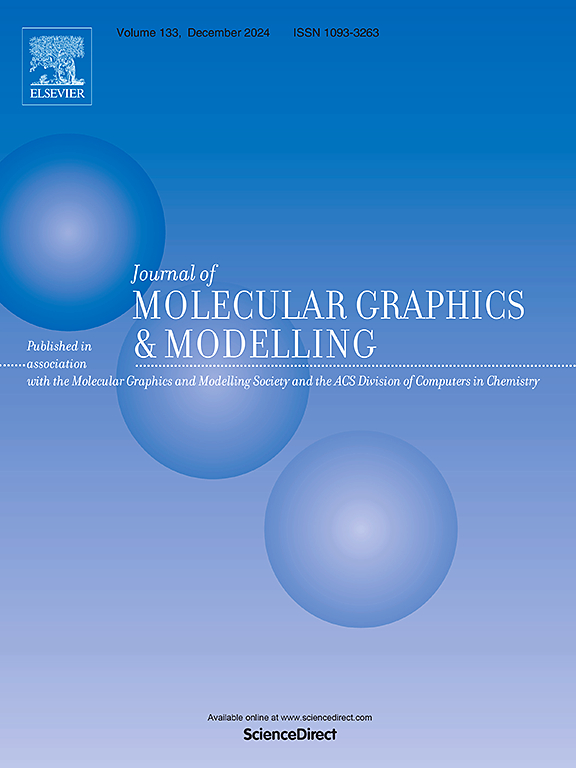In silico screening of peptide inhibitors targeting α-synuclein for Parkinson's disease
IF 3
4区 生物学
Q2 BIOCHEMICAL RESEARCH METHODS
引用次数: 0
Abstract
Parkinson's disease affects cognitive, motor, and autonomic functions due to nervous system degeneration. Though no cure exists, medications and therapies can help alleviate symptoms, but their effectiveness diminishes as the disease progresses, ultimately increasing the need for alternative treatments. α-Synuclein has long been one of the main targets in addressing Parkinson's through drug design studies, but no drugs are yet approved against α-Synuclein aggregation. Therefore, this study aims to develop potential inhibitors of fibrillization by screening thousands of peptides in terms of their binding abilities via Molecular Docking and Molecular Dynamics simulations. Our results show that peptides with Lysine and Arginine at terminal groups result in higher binding affinities to the C-terminal domain. Among the heptapeptides examined, RWRRKRL shows the highest binding free energy to the protein while KKRHKWR exhibits superior stabilizing effect, interacting with both N- and C-terminal regions of α-Synuclein. The inhibitory potential of peptides on the fibrillar structure of protein varies with concentration, and RWRRKRL at 1:3 protein-peptide monomer ratio shows promise as an inhibitor by reducing the internal H-bonds of the protein and increasing RMSD values. These results reveal that short-chain peptides can be designed against α-Synuclein oligomerization offering a potential therapeutic approach for preventing Parkinson's.

帕金森病α-突触核蛋白肽抑制剂的筛选
帕金森氏症由于神经系统退化而影响认知、运动和自主神经功能。虽然没有治愈的方法,但药物和疗法可以帮助缓解症状,但随着疾病的进展,它们的效果会减弱,最终增加了对替代治疗的需求。α-Synuclein长期以来一直是通过药物设计研究治疗帕金森病的主要靶点之一,但目前尚未批准针对α-Synuclein聚集的药物。因此,本研究旨在通过分子对接和分子动力学模拟来筛选数千种肽的结合能力,以开发潜在的成纤维抑制剂。我们的研究结果表明,在末端基团上有赖氨酸和精氨酸的肽与c端结构域的结合亲和力更高。在所检测的七肽中,RWRRKRL与α-Synuclein的结合自由能最高,而KKRHKWR与α-Synuclein的N端和c端均相互作用,具有较好的稳定作用。多肽对蛋白质纤维结构的抑制电位随浓度的变化而变化,RWRRKRL在蛋白-肽单体比为1:3时,通过降低蛋白质的内部氢键和增加RMSD值,显示出作为抑制剂的前景。这些结果表明,短链肽可以设计用于α-突触核蛋白寡聚,为预防帕金森病提供了一种潜在的治疗方法。
本文章由计算机程序翻译,如有差异,请以英文原文为准。
求助全文
约1分钟内获得全文
求助全文
来源期刊

Journal of molecular graphics & modelling
生物-计算机:跨学科应用
CiteScore
5.50
自引率
6.90%
发文量
216
审稿时长
35 days
期刊介绍:
The Journal of Molecular Graphics and Modelling is devoted to the publication of papers on the uses of computers in theoretical investigations of molecular structure, function, interaction, and design. The scope of the journal includes all aspects of molecular modeling and computational chemistry, including, for instance, the study of molecular shape and properties, molecular simulations, protein and polymer engineering, drug design, materials design, structure-activity and structure-property relationships, database mining, and compound library design.
As a primary research journal, JMGM seeks to bring new knowledge to the attention of our readers. As such, submissions to the journal need to not only report results, but must draw conclusions and explore implications of the work presented. Authors are strongly encouraged to bear this in mind when preparing manuscripts. Routine applications of standard modelling approaches, providing only very limited new scientific insight, will not meet our criteria for publication. Reproducibility of reported calculations is an important issue. Wherever possible, we urge authors to enhance their papers with Supplementary Data, for example, in QSAR studies machine-readable versions of molecular datasets or in the development of new force-field parameters versions of the topology and force field parameter files. Routine applications of existing methods that do not lead to genuinely new insight will not be considered.
 求助内容:
求助内容: 应助结果提醒方式:
应助结果提醒方式:


